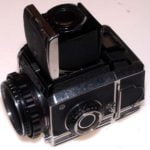Originally posted 2013-04-12 19:28:25.

In the last article we looked at the optical principles that govern focus and depth of field. Now let’s explore how these are applied practically in the camera. For the moment we will assume that we are using a single-lens-reflex (slr) or rangefinder type camera, either digital or film.
If you look at the lens barrel you will probably see a ring which controls the aperture diaphragm. This will be numbered in f-stops, which on modern cameras will run f1.4,2, 2.8, 4, 5.6, 8, 11, 16, 22, (32, 45, 64). I put the last three in brackets because you’re pretty unlikely to have them but you might see them on view cameras. Note that the numbers double on every second step—2,4,8 etc and 2.8, 5.6, 11 etc. The f-stops are determined by dividing the effective aperture into the focal length, so a 50mm lens with an aperture of 25mm is f2, and with 12.5mm is f4. Each f-stop, going from low number to high, admits half as much light as the one before, so f2.8 is half of f2 etc. It’s easy to work out why if you’re mathematically inclined, but if not, just remember it.
I n modern slr cameras the aperture is held fully open until the shutter is tripped, so you won’t be able to see the operation of the aperture ring unless you take the lens off the camera.
n modern slr cameras the aperture is held fully open until the shutter is tripped, so you won’t be able to see the operation of the aperture ring unless you take the lens off the camera.
Also on the lens will usually be some method of focussing manually (though not always) and a scale of distance. Now usually there will be pairs of marks on the scale of distance that correspond to the aperture f-stops. These show the approximate depth of field at each aperture for that distance. So if the subject is in focus, this distance will be on the central datum and objects in front of and behind it will be within the depth of field as long a they are inside the distances marked by the depth of field aperture marks for the aperture set. Clearly, since depth of field changes with focal length, this is more complex to arrange on zoom lenses, but most have something.
It would be easy to assume that the object is to have as much depth of field as possible, but this is not true. Being able to throw foreground and background out of focus is very useful for isolating the subject and is very useful in portraiture and in other cases where the background is distracting. So a knowledge of the consequences, for depth of field, of the aperture being used, is essential for a serious photographer.
Depth of field preview
If your camera has a depth of field preview, and if you have not already bought your camera then I recommend you to find one equipped like this, then experiment by holding the camera to your eye and focussing on subject about 15-20 feet away (5-6m). This is best done outside in good light. Open the aperture right up and then operate the depth of field preview, at the same time slowly rotating the aperture till it is fully stopped down. You will notice two things: first that the scene gets very dark! And secondly you should see how the objects in the foreground and distance seem to snap into focus as the aperture gets smaller.
The depth of field preview is of limited use in low light, and is best when the camera is on a tripos, so it’s a good idea to practise doing this so that you get a real feel for the effects of stopping down with each lens. If you are using digital, try making a series of exposures, one at each f-stop, and comparing them later on the computer. The differences will be quite pronounced, and you will see how the depth of field extends with stopping down.
Diffraction
One final point. There is a misconception that the more a lens is stopped down the sharper it will be. This is not true. There is a phenomenon called diffraction which affects all lenses; it is caused by the edge of the diaphragm ‘bending’ light. At larger apertures this is overwhelmed by the undiffracted ‘good’ light, but as you stop down its effects become more pronounced, and are visible in a degradation of resolving power. This means that at the smallest apertures, images will not be quite as sharp. Taking lenses are usually designed to be at their sharpest 4-6 stops down from fully open, and this is one reason why lens manufacturers make it impossible to stop their lenses down as far as they theoretically could be.
Because of this, you shouldn’t be able to stop your lens down to cause observable degradation, but be aware that your lens is sharpest around the middle of its aperture range. People who use large cameras, 5×4 or particularly 10×8 and up, often stop right down, but this is to maximise depth of field; since they are enlarging only a little or contact printing, the small loss of resolving power caused by diffraction is not a concern to them.
Bokeh.
Although a slight divergence from the main theme here, ‘bokeh’ gets a lot of attention. This is a Japanese word that refers to the way a lens resolves out-of-focus highlights, particularly in the background. The bokeh changes with the amount of stopping down. Everyone has their own preferences: I like a nice soft ‘doughnut’ of light. However, lens manufacturers don’t really consider bokeh when they design lenses, so it’s really a matter of trying lenses to see before you buy. Good bokeh does not always go with maximum performance in other areas. You should be able to get some idea of a lens’s bokeh by stopping down, so always do so when buying, if this is important to you.

